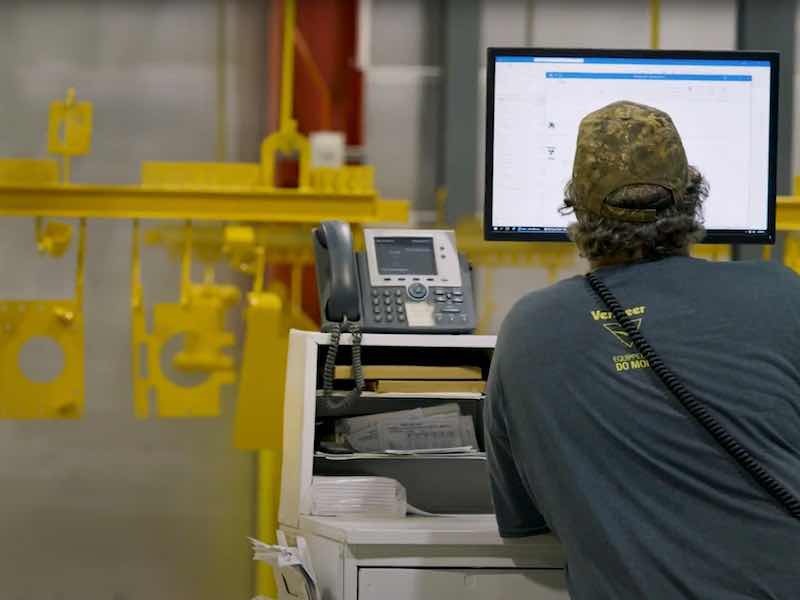Designing a new in-house coating line from scratch is often a once-in-a-lifetime experience for some finishing managers.
And for Tom Clawson, senior paint engineer at Vermeer in Pella, Iowa — an industrial and agricultural equipment manufacturing company — he wasn’t going to take any chances in not getting it right.
 Tom Clawson“We probably went through 20 different layouts,” Clawson says. “They would send something, and I’d tweak it a little bit. Then I’d be with our executive team, and we would go back and forth, back and forth. We wanted to get it right.”
Tom Clawson“We probably went through 20 different layouts,” Clawson says. “They would send something, and I’d tweak it a little bit. Then I’d be with our executive team, and we would go back and forth, back and forth. We wanted to get it right.”
The designer and builder of the new paint line for Vermeer — which went into operation in late 2020 — completely understood Clawson and his team’s desire to get it right.
Getting Creative on Design
“They were getting pretty creative,” says Calvin Wilson, president of Belco Industries in Belding, Michigan. “We wanted to give them what they want. I told them upfront, if you’ve got ideas, we’re more than happy to listen to them.”
One of the top priorities for Vermeer was to build redundancies in the paint line to increase efficiency in the future. For example, Clawson wanted backup plans in place for the multi-stage washer in the event something failed.
He had consulted with a few other companies over the years about how they set up their pumps, and several of them said they wouldn’t do it the way Clawson originally requested because of the risk of one of the pumps going down.
“A lot of your washer companies will set a pump to do the right side, and then the other pump will do the left side,” Clawson says. “I wanted one pump to do the front half, and the second pump would do the back half. The best-case scenario would be if a pump or a riser breaks or something goes wrong, you shut that pump down, and we reduce the speed going through the washer.”
That would give the third-shift maintenance team at Vermeer the time to go in and perform the repair without shutting the line down entirely.
Redundancy is the Key to Increasing Efficiency
 And redundancy is the key to the ongoing success at Vermeer these days after disaster struck in July 2018 when an EF-3 tornado packing winds as high as 160 miles per hour destroyed two of the company’s seven production plants and heavily damaged numerous others.
And redundancy is the key to the ongoing success at Vermeer these days after disaster struck in July 2018 when an EF-3 tornado packing winds as high as 160 miles per hour destroyed two of the company’s seven production plants and heavily damaged numerous others.
With over 2,700 team members working at the Vermeer campus — and over 400 customers who came to the facility as part of a 70th-anniversary celebration — the biggest concern that day was the safety of team members and visitors.
But the damage to the facility was extensive, including the numerous paint lines that were spread amongst the seven plants on the campus. Vermeer lost three coating lines that day that were totally or partially damaged in the disaster.
Following the July tornado, Vermeer immediately began reassembling whatever coating line parts they could put together. They had a makeshift line up and running by mid-October of 2018 and were able to start running parts again a few weeks later.
Those hectic days are not lost on Clawson. In fact, he and the Vermeer management team had been talking about adding a new coating line — including one that might include powder coating — even before the tornado struck.
“Prior to the tornado, we were researching the replacement of some of our lines,” he says. “About half of our paint lines were starting to become outdated.”
Handling Triple the Volume
 Vermeer in Pella, Iowa is an industrial and agricultural equipment manufacturing company.With increasing production, Vermeer soon realized they were unable to get parts through the paint systems the way they wanted.
Vermeer in Pella, Iowa is an industrial and agricultural equipment manufacturing company.With increasing production, Vermeer soon realized they were unable to get parts through the paint systems the way they wanted.
Meanwhile, it was decided that the two buildings destroyed in the tornado would not be rebuilt. Vermeer would instead expand their Plant 7 facility with a new welding, assembly, and paint area and a central receiving station.
Without the rebuilding of the two plants, Vermeer decided to expand the necessary throughput by building a new paint line that would handle triple the volume.
The original plan was to add a new powder coat line to tie into the two planned liquid paint lines (the primer and topcoat). As costs began increasing, the Vermeer team decided to put a hold on the powder coat line, although they wanted the system designed to be able to integrate a powder line down the road.
“We have designed a conveyor system, and there’s a kickoff already in place,” Clawson says. “It’s just a matter of purchasing the powder components to put it in, but we’re holding off on that for a while.”
The Goal of Having 600 Load Bars Coated per Shift
 Preston RhamyVermeer measures throughput in 5-foot load bars that run through the system during an 8-hour period; the load bars may have multiple, single, or several larger parts hanging from them. The goal was to have 600 load bars run through the system each shift.
Preston RhamyVermeer measures throughput in 5-foot load bars that run through the system during an 8-hour period; the load bars may have multiple, single, or several larger parts hanging from them. The goal was to have 600 load bars run through the system each shift.
The lines through the multi-stage washers run at about 18 feet per minute and transfer to two different lines, each running at 6 feet per minute when it gets to the coating booths. When they eventually add the powder line, it will also run about 6 feet per minute so that everything syncs together from the washer speed.
With the design specs in mind, Clawson and Preston Rhamy, senior process engineering manager for advanced manufacturing at Vermeer, began searching for a manufacturer of the new paint system. They started across town with Pella Corporation, a door and window manufacturer and customer of Belco.
“They have used Belco for several years, and I’ve talked to their engineers and maintenance personnel,” Clawson says. “Pella Corporation gave Belco high praise. I also spoke with Quality Manufacturing in Des Moines, and they also gave a very high recommendation.”
Along with lead time and pricing of other manufacturers, what attracted Vermeer more than anything to Belco was the fact that they designed and manufactured all the components at their Michigan facility, and they sent their own crews to install the systems.
Needing a Turnkey Manufacturer
 What attracted Vermeer to Belco was the fact that they designed and manufactured all the components at their Michigan facility, and they sent their own crews to install the systems.“Some of the other companies I talked to were outsourcing everything to get it here,” Clawson says. “And then there would be different crews here setting up each component. We typically shy away from that; we want a company to come in and put together a turnkey operation.”
What attracted Vermeer to Belco was the fact that they designed and manufactured all the components at their Michigan facility, and they sent their own crews to install the systems.“Some of the other companies I talked to were outsourcing everything to get it here,” Clawson says. “And then there would be different crews here setting up each component. We typically shy away from that; we want a company to come in and put together a turnkey operation.”
From there, Belco went to work designing the system to the specifications of Vermeer and thus began the review and change period, where the line was fine-tuned.
Wilson, Belco Industries president, says they agreed it would be a good idea to split the stages on the multi-stage washing system to provide the redundancies that Vermeer was seeking.
“We put pumps on all the stages and split the risers so that if one pump went down, they could still at least run at half speed,” he says. “We communize as much as we possibly could.”
Belco was founded in 1959, selling aluminum extrusion equipment, and soon morphed into designing, building, and installing paint, powder coating, and electrocoat systems, as well as auto deposition and vertical finishing systems for aluminum extrusions.
 Calvin WilsonThey also manufacture custom washers, ovens, and paint spray booths, too, and Wilson says having the design, manufacturing, and installation teams all under one roof has distinct advantages.
Calvin WilsonThey also manufacture custom washers, ovens, and paint spray booths, too, and Wilson says having the design, manufacturing, and installation teams all under one roof has distinct advantages.
“We did some preparatory design work so that they could add the powder in the future,” he says. “The system is built in a way that they can add that on and not disrupt their production in any way.”
After seven months in operation, Vermeer reports minimal interruptions with the Belco equipment.
For Rhamy, who oversees all of the paint operations at Vermeer, the new line has been an extreme blessing in what has been an otherwise chaotic last four years.
“In every crisis, there’s an opportunity,” he says of the rebuild from the tornado. “We certainly took advantage of the crisis to come back and come back better.”
Rhamy says the paint operations have always had work funneled to them from the various other manufacturing divisions at Vermeer, whether it be machine tool or the fabrication department.
“We are fine with being a funnel, but we’re not fine with being a bottleneck,” he says. “And that’s what we were looking to solve.”
With the paint department feeding nine assembly lines and a service parts line, Rhamy says the equipment and quality for the coatings division needed a line that was on the top of its game.
“We need to drive reliability,” Rhamy says. “And we certainly are.”








































